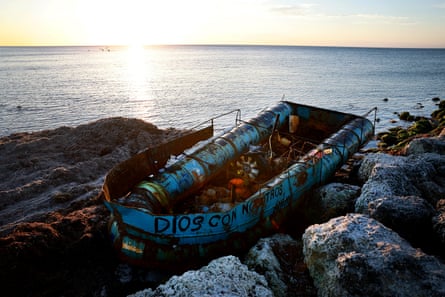For almost six years the US embassy in Havana has lain silent in the withering Caribbean sun. Tiles have fallen from its facade, the fence has rusted and the awning of the consular section has been shredded in the fierce winds off the Florida Straits.
Last year, though, a new blue awning appeared and US state department SUVs began to arrive. And then, last week, queues of Cubans appeared outside, as the embassy resumed full immigrant visa services for the first time since 2017.
Abel Alonso, a cardiovascular technician from Miami, waited in the nearby park with his parents-in-law, Percida and Bildo. “It all depends how fast they issue a visa,” he said. “But they have an appointment and I hope they will be at home with us in a month.”
The return of full consular services comes as Joe Biden tries to stem the latest migration crisis on the southern border of the US. The president has announced that 30,000 migrants from Cuba, Haiti, Nicaragua and Venezuela will be allowed to legally enter the country every month.
In the past year 250,000 Cubans – more than 2% of the island’s population – have been detained after attempting to cross the US border illegally. Most migrants from the island travel overland from Central America, but significant numbers attempt the perilous crossing by boat, with 300 picked up in the Dry Tortugas national park near Key West last week. The exodus shows no sign of tailing off.
Biden has said that those attempting to cross to the US illegally will now be stopped, strengthening Trump-era policies that have turned away migrants from Haiti and the rest of Latin America, but – until now – not Cubans.
Migrants from the island have long had privileged access to the US, but in recent years those privileges have gradually been whittled away. In 2017 Barack Obama ended the so-called wet foot/dry foot policy that gave any Cuban who managed to put a foot on US territory a route to residency (in contrast with Haitian migrants, who were routinely returned home no matter where they were detained).
Another blow came with the closure of the US embassy’s consular section after 26 officials reported falling ill after mysterious debilitating “sonic attacks”.
The Cuban government unambiguously denies any involvement in the alleged attacks, but the closure meant that Cubans wishing to apply for legal entry to the US had to go instead to Guyana on the north coast of South America.
Cristina Suárez used that route to bring her teenage stepdaughter to the US.
“Because of the pandemic there were few flights,” she said. “In the end we paid about $6,000 [to get her to Guyana]. That cost excluded a bunch of people whose family cannot pay that sort of money.”

Meanwhile Cuba’s already moribund economy nosedived during the pandemic, and th


